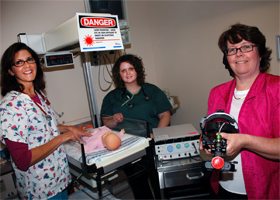Feature Story
Health Center Today, October 27, 2010
A Sight-Saving Laser Eye Procedure for Premature Babies
By Carolyn Pennington

Neonatal Intensive Care nurses Jan Ciemier, Kathryn Ireland and Terry Donovan (left to right) during a demonstration of a laser eye procedure.
Photo by Janine Gelineau
With advances in neonatal care, smaller and more premature infants are being saved, but with that comes a greater risk for certain health problems such as retinopathy of prematurity (ROP).
ROP is one of the most common causes of visual loss in childhood and can lead to lifelong vision impairment and blindness. The disorder usually develops in both eyes and the smaller a baby is at birth, the more likely the baby is to develop ROP. “The average birth weight of our babies who go on to develop ROP requiring laser treatment is around 1 lb. 6 oz. and 24 weeks gestation,” says Terry Donovan, clinical nurse specialist in the Health Center’s Neonatal Intensive Care Unit.
ROP occurs when abnormal blood vessels grow and spread throughout the retina, the tissue that lines the back of the eye. “When a baby is born full-term, the retinal blood vessel growth is mostly complete,” says Donovan. “But if a baby is born prematurely, before these blood vessels have reached the edges of the retina, normal vessel growth may stop.”
New blood vessels that are abnormal and fibrous tissue (like scar tissue) can form in the retina. These abnormal blood vessels may be twisted and bending, or fragile and leaking, scarring the retina and pulling it out of position. This causes a retinal detachment. Retinal detachment is the main cause of visual impairment and blindness in ROP.
The babies who are most at risk routinely get eye exams to see how the blood vessels are developing in the retina. If Dr. Christopher Kelly, an ophthalmologist with Children’s Eye Care, suspects ROP and it requires treatment, he will call in a retinal specialist. Within 72 hours, the retinal specialist will perform laser eye surgery on the baby with the assistance of a neonatologist and two nurses.
The laser therapy destroys the peripheral areas of the retina, slowing or reversing the abnormal growth of blood vessels. “While the laser treatment decreases the chances for vision loss, not all babies respond the same and a percentage of babies will still have some limited vision,” explains Donovan. “But before laser treatment for severe ROP was an option it was almost assured the baby’s retina would detach and the baby’s chance of being blind would greatly increase.”
Since the Health Center started performing laser therapy three years ago, they have performed 22 procedures. Ten Health Center nurses have been specially trained for the procedure which includes laser safety training and knowing how to accurately position and monitor the baby during the procedure.


